Discover the creativity and engineering behind Knex Ferris wheel construction, a popular hobby combining art and mechanics. Build functional, intricate models while learning about balance and motion.
1.1 Brief History of Knex and Ferris Wheel Models
Knex, a beloved construction toy, has been inspiring creativity for decades. Its classic rods and connectors allow users to build intricate models, including Ferris wheels. The first Knex Ferris wheel sets emerged in the 1990s, offering step-by-step instructions for amateur builders. Over time, Knex introduced larger, more complex designs, such as the 6-foot Ferris wheel, showcasing their commitment to innovation and detail in toy engineering.
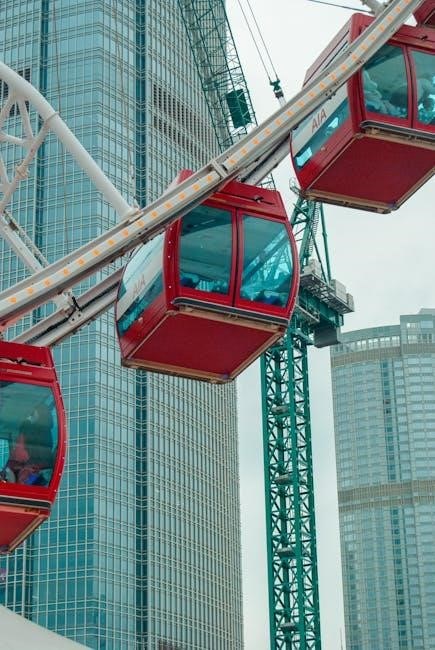
1.2 Why Build a Knex Ferris Wheel?
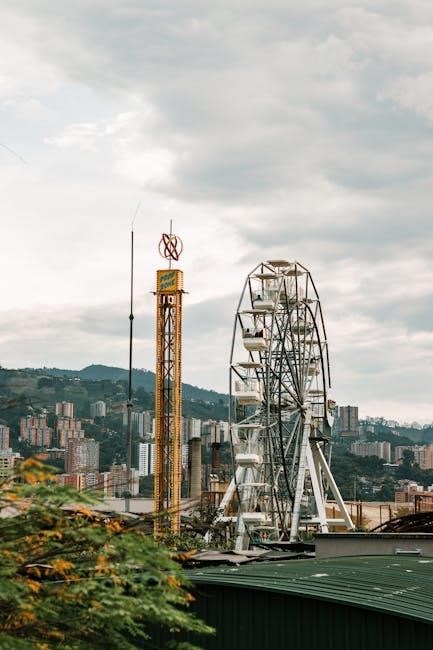
Building a Knex Ferris wheel fosters creativity, problem-solving, and engineering skills. It offers a fun, hands-on way to learn about mechanics and balance while creating a functional model. The process is rewarding, allowing you to see your ideas come to life. Whether for personal enjoyment or as a gift, a Knex Ferris wheel is a unique project that combines art and science, providing hours of educational entertainment.
1.3 Safety Tips and Precautions
When building a Knex Ferris wheel, ensure a stable workspace to avoid accidents. Handle small parts carefully to prevent choking hazards. Use a Phillips screwdriver safely and insert batteries correctly. Keep loose clothing tied back and avoid overreaching. Follow instructions precisely to maintain balance and stability. Adult supervision is recommended for younger builders. Regularly inspect the structure for loose connections to ensure durability and safe operation.
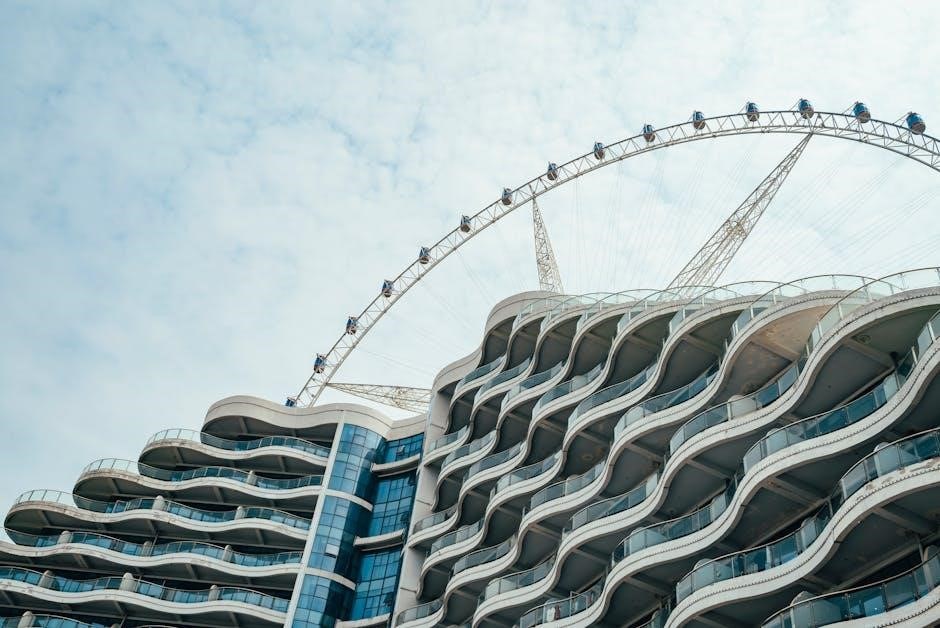
Tools and Materials Needed
Gather Knex rods, connectors, wheels, and a motor. Additional tools include a screwdriver for battery installation and a stable workspace. Ensure all parts are included.
2.1 List of Required Knex Parts
The essential Knex components include assorted rods, connectors, wheels, and a motor. Specific sets like the 6ft Ferris Wheel (product 89790) require 500 rods and connectors, 4 wheels, and a motor. Ensure all pieces from the set are included for assembly. Additional tools like a screwdriver and batteries are needed for motorized operation. Refer to the manual for a detailed inventory of required parts.
2.2 Additional Tools (e.g., Screwdriver, Batteries)
Beyond Knex pieces, you’ll need a small Phillips head screwdriver for motor assembly and 2 fresh AA batteries for power. Ensure correct polarity when inserting batteries to avoid damage. A screwdriver is essential for tightening connections and securing parts. These tools are critical for completing the Ferris wheel’s motorized function and ensuring stability during operation.
2.3 Workspace Setup Recommendations
Organize your workspace on a flat, stable table or countertop. Sort Knex parts by type to streamline assembly. Use a screwdriver and batteries nearby for motor installation. Ensure good lighting and a clean environment. Consider using small organizers for tiny components. Patience and a systematic approach are key to avoiding clutter and ensuring a smooth building experience.

Understanding the Basic Components
The Knex Ferris wheel relies on rods, connectors, and gears for structure and motion. Motors power rotation, while seats and supports ensure stability and safety for riders.
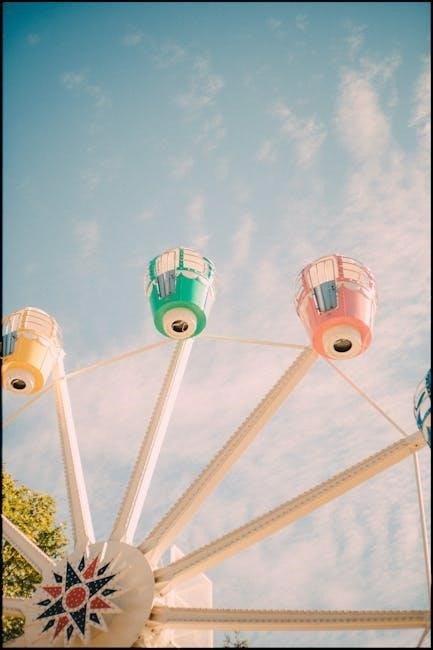
3.1 The Wheel Structure
The wheel structure forms the backbone of the Ferris wheel, requiring precise assembly of rods and connectors to ensure circular stability. Proper alignment of the frame ensures smooth rotation. Motor integration is crucial for movement. A sturdy design prevents wobbling, while balanced weight distribution maintains functionality. Detailed instructions guide the assembly of this critical component, ensuring durability and safety for the entire model.
3.2 The Seat Design
The seats are essential for the Ferris wheel’s functionality and safety. Constructed from rods and connectors, they provide a secure space for riders. Proper attachment to the wheel frame ensures smooth rotation and balance. Tips for stability include using small connectors to reinforce the seat base, ensuring durability and rider safety. Detailed instructions guide the assembly of this vital component, emphasizing secure connections for optimal performance and reliability.
3.3 The Motor Mechanism
The motor mechanism powers the Ferris wheel’s rotation, requiring precise assembly. Use a small Phillips screwdriver to secure the motor and ensure proper gear alignment. Install fresh AA batteries, following polarity guidelines, to activate the system. Detailed instructions outline step-by-step installation, emphasizing secure connections for smooth operation. Ensure all gears mesh correctly to avoid jamming and maintain consistent rotational speed for optimal performance and durability.
3.4 The Support Stand
The support stand is essential for maintaining the Ferris wheel’s stability and balance. Assemble it using specific rods and connectors to create a sturdy base. Attach the stand securely to the base to prevent wobbling. Ensure all connections are tight and the stand is level. Proper assembly guarantees the Ferris wheel operates smoothly without tipping. Follow the instructions carefully to achieve maximum stability and durability.
Step-by-Step Assembly Instructions
Follow detailed step-by-step instructions to build the Ferris wheel, starting with the wheel frame, then attaching seats, installing the motor, constructing the stand, and final testing.
4.1 Building the Wheel Frame
Start by constructing the circular frame using Knex rods and connectors. Sort the parts and follow the manual to form a sturdy base. Attach spacers and supports to maintain symmetry; Ensure the frame is level and secure. Tighten all connections firmly. This step is crucial for stability and proper rotation of the Ferris wheel.
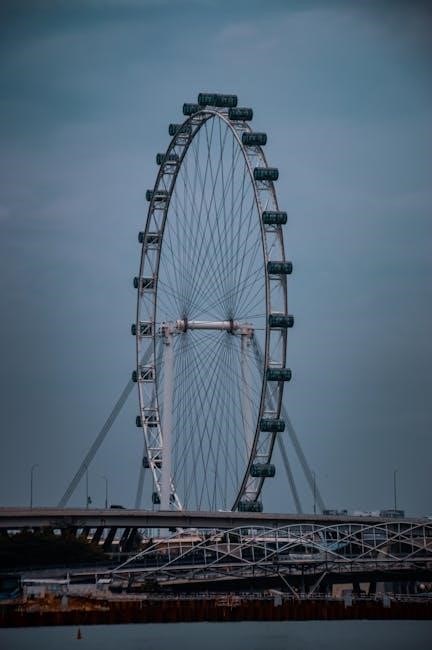
4.2 Attaching the Seats
Once the wheel frame is built, attach the seats by clipping them securely to the frame using Knex connectors. Ensure each seat is evenly spaced for balance. Align the seat hooks with the frame’s openings and snap them into place. Tighten all connections firmly. Most models include 6-8 seats, so repeat the process until all are attached. Double-check for proper alignment to ensure smooth rotation.
4.3 Installing the Motor

Align the motor with the axle on the wheel frame and secure it using the provided screws. Insert fresh AA batteries into the motor compartment, ensuring correct polarity. Gently tighten the screws to avoid stripping the threads. Once installed, test the motor by turning it on to ensure smooth rotation. If the motor hesitates, check the connections and balance of the wheel. Proper installation ensures reliable operation.
4.4 Constructing the Support Stand
Begin by assembling the base using flat Knex pieces to create a sturdy foundation. Attach vertical rods to the base, ensuring they are evenly spaced and secure. Connect horizontal supports between the rods for added stability. Use angled connectors to form a triangular frame for the stand. Finally, attach the stand to the wheel’s base, ensuring it is level and firmly anchored. Tighten all connections for maximum stability.
4.5 Final Assembly and Testing
Attach the wheel, seats, and motor to the support stand, ensuring all connections are secure. Conduct a visual inspection to verify proper alignment and stability. Test the motor by turning it on, observing smooth rotation and consistent movement. Check for any wobbling or noise, making adjustments as needed. Finally, ensure the Ferris wheel operates safely and efficiently, completing the project with a fully functional and balanced structure.
Troubleshooting Common Issues
Identify misaligned parts, loose connections, or motor malfunctions. Check for missing pieces and ensure proper assembly. Adjust balance and tighten components to restore smooth operation and stability.
5.1 Common Mistakes and Solutions
One common issue is misaligned gears causing the motor to stall. Ensure all gears mesh properly and are securely attached. Another mistake is loose connections in the wheel frame, which can lead to instability. Tighten all joints firmly but avoid over-tightening, which might strip the parts. Additionally, incorrect seat installation can disrupt the wheel’s balance. Always refer to the manual for correct placement and alignment to maintain smooth operation and prevent structural issues.
5.2 Adjusting the Balance and Stability
Ensure the Ferris wheel’s balance by checking the alignment of all components. Tighten any loose connections and verify that the seats are evenly distributed. If the wheel wobbles, adjust the support stand’s legs for stability. Spin the wheel manually to identify imbalance and make necessary adjustments. Proper alignment and secure connections are crucial for smooth operation and preventing structural failure during rotation.
5;3 Fixing the Motor and Gear System
Identify issues with the motor by checking power connections and ensuring batteries are installed correctly. Inspect gears for proper alignment and lubricate if necessary. If the motor stalls, verify that the gear system is free from obstructions. Replace worn-out gears or misaligned components to restore smooth operation. Ensure the motor is securely attached to the frame to prevent vibration-related damage during rotation.
Customization and Enhancement Ideas
Enhance your Knex Ferris wheel by adding lights, sounds, or paint. Expand its size or complexity for a unique, personalized creation that showcases your creativity and skill.
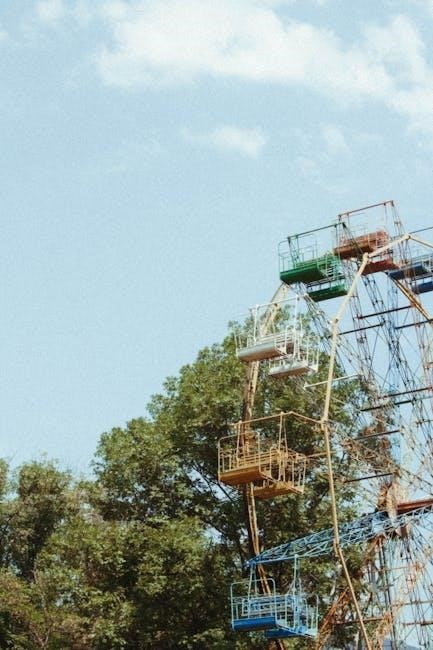
6.1 Adding Lights or Sounds
Elevate your Knex Ferris wheel by incorporating LED lights or sound effects. Use small LED strips to illuminate the wheel’s structure or add a music player with synchronized sounds. Ensure batteries are securely placed and wires are neatly organized to maintain stability. This adds a dynamic, interactive element, making your creation more engaging and visually appealing while showcasing your creativity and technical skills.
6.2 Painting or Decorating the Ferris Wheel
Personalize your Knex Ferris wheel by painting or decorating it with vibrant colors and creative designs. Use non-toxic, water-based paints to add unique patterns or themes to the seats, structure, or supports. Consider adding stickers, decals, or glow-in-the-dark accents for extra flair. You can also theme your Ferris wheel to match a specific style, such as a vintage carnival or futuristic design, enhancing its visual appeal and making it truly one-of-a-kind.
6.3 Expanding the Size or Complexity
Take your Knex Ferris wheel to the next level by expanding its size or adding intricate details. Use additional rods, connectors, and specialized parts like gears or pulleys to create a larger, more complex design. Consider adding multiple layers, interactive elements, or even a second wheel for a unique twist. Incorporating motors or lighting systems can also enhance functionality and visual appeal, making your Ferris wheel a standout creation that showcases your creativity and engineering skills.
Congratulations on completing your Knex Ferris wheel! This project showcases your creativity and engineering skills, giving you a sense of accomplishment. Share your creation to inspire others and continue building with Knex for endless fun and learning.
7.1 Final Tips for Successful Completion
Ensure all parts are securely connected and test each component before final assembly. Follow instructions carefully and double-check your work. Use a small Phillips screwdriver for battery installation and maintain balance for smooth operation. Be patient, as precision is key. Celebrate your accomplishment and consider sharing your creation online for inspiration. Happy building with Knex!
7.2 Encouragement to Share Your Creation
Share your finished Ferris wheel with friends, family, or online communities to showcase your creativity. Join Knex enthusiast forums or social media groups to inspire others and gain feedback. Your unique design could spark ideas for fellow builders. Be proud of your accomplishment and enjoy the joy of creating something truly impressive with Knex!